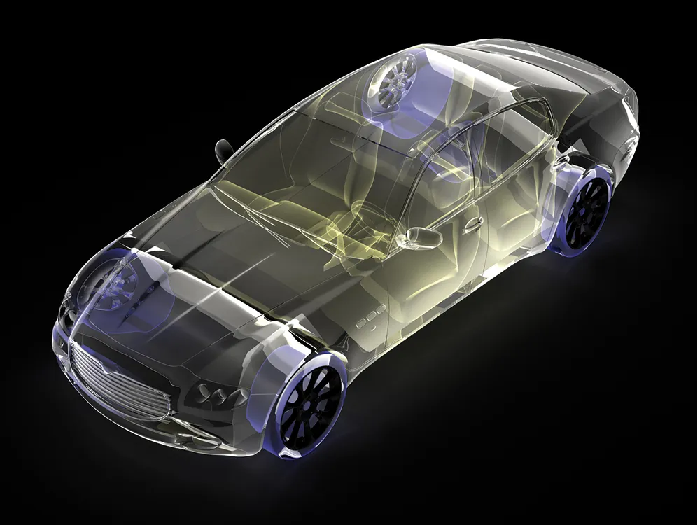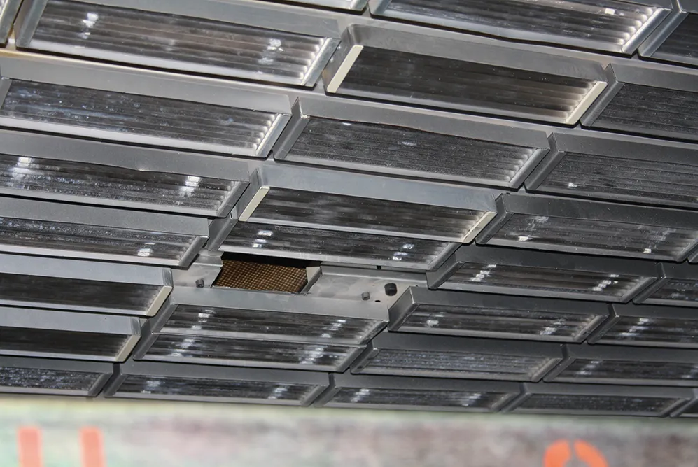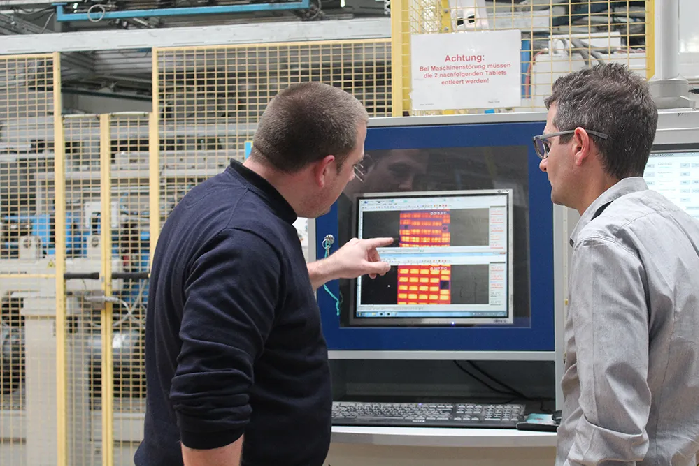Producing automotive exterior parts through thermoforming presents numerous challenges, especially in ensuring uniform temperature distribution across composite fiber sheets, which are usually 2.3 to 3.5 mm thick and reinforced with glass fibers.
Accurately heating these sheets is critical to prevent faults like burning or folding during deep-drawing. The heating happens through various high- and low-level radiant heaters inside the thermoforming machine before the sheets are pressed and cooled in a mold to create the panels.
Reducing the handling time between heating and forming is pivotal to avoid irregularities that could increase scrap and decrease effectiveness.
The manufacturing process also includes the simultaneous forming of functional components, including air inlet nozzles, and later stages like laser cutting and final shaping before the parts are transported to the purchaser for construction.

Image Credit: Optris GmbH & Co. KG
Achieving a stable process with optimal cycle times and minimal faults is crucial. During development, issues such as panel parts burning or folds forming because of incorrect temperature settings underscore the need for frequent temperature monitoring and accurate radiant heater control.
Such efforts include displaying the temperature profile across the plastic sheet, streamlining heater temperature regulation, and optimizing plant utilization.
These steps assist in reducing cycle times, increasing efficiency, and ensuring the highest quality standards while strengthening customer satisfaction and loyalty.
Reliable temperature control throughout thermoforming is essential for producing high-quality automotive exterior parts that meet industry standards, protecting the company’s reputation, and ensuring customer trust.
Optimizing Temperature Control in Automotive Thermoforming with Infrared Technology
The Gubesch Group is a leader in innovative thermoforming and injection molding technologies and improves automotive exterior part production with the Optris PI Series infrared camera.
Early attempts to monitor temperatures using pyrometers on each side were ineffective because of major temperature fluctuations across the material; even installing multiple pyrometers in a row failed because the attainable resolution was too low.
The Optris PI infrared camera provided the perfect solution. Its broad-region temperature measurement ability precisely captures individual temperature fluctuations, including hot and cold spots, and delivers complete temperature profiles across the whole composite fiber sheet.
To enhance performance, a 64 ° wide-angle lens was fitted in the starter field's top and bottom heating sections. As ambient temperatures near the heating system can reach up to 315 °C, the cameras were stored in water-cooled enclosures with extra decoupled plates to maintain a fixed ambient temperature of 35–40 °C.

Image Credit: Optris GmbH & Co. KG
This setup ensures that the camera’s internal temperature stays below its highest operational threshold of 50 °C, which the Optris PIX Connect software continually observes.
Optris PIX Connect software is key in evaluating temperature. It offers comprehensive IR camera software for calculating and recording temperatures while automatically controlling procedures. With video and snapshot recordings at up to 80 Hz, the software is highly customizable to meet specific user requirements.
For easy operation, alarms appear in a pop-up window with advised actions for users, guaranteeing quick and precise responses.
The cameras connect to a computer via USB, and their process interface enables external trigger signals to be sent. This produces automatic snapshots initiated by voltage signals from the machine control system, which are kept in a display history as an essential part of the process documentation.
Strategic Infrared Camera Use in Thermoforming Maximizes Yield and Quality
The Gubesch Group’s use of the Optris PI thermal imaging camera has delivered considerable benefits, predominantly through enhancing production processes via consistent temperature monitoring and accurate radiant heater control.
This advanced regulation achieves optimal cycle times of 90 seconds at maximum heating power, greatly enhancing profit and efficiency. The scrap yielded has been drastically reduced by maintaining a steady temperature profile.
The Gubesch Group’s primary advantage is ensuring the highest quality standards. Accurate temperature control meets strict customer demands, fostering loyalty and increasing order volumes. The specialist chose the Optris PI due to its positive experience with pyrometers for folding units in bending procedures.

Image Credit: Optris GmbH & Co. KG
The dependability of Optris devices and the broad range of infrared measurement devices, accessories, and software selections, proved beneficial for the new series production.
Optris offers durable thermal imaging solutions for industrial use, including IP67-rated cameras with industrial plugs, key components like cooling housings, and effortless integration with existing plant systems via USB interfaces.
The license-free, complete camera software for thermal image analysis and complimentary access to data transmission interfaces reinforced the decision to select the Optris PI thermal imaging camera.

This information has been sourced, reviewed and adapted from materials provided by Optris GmbH & Co. KG.
For more information on this source, please visit Optris GmbH & Co. KG.